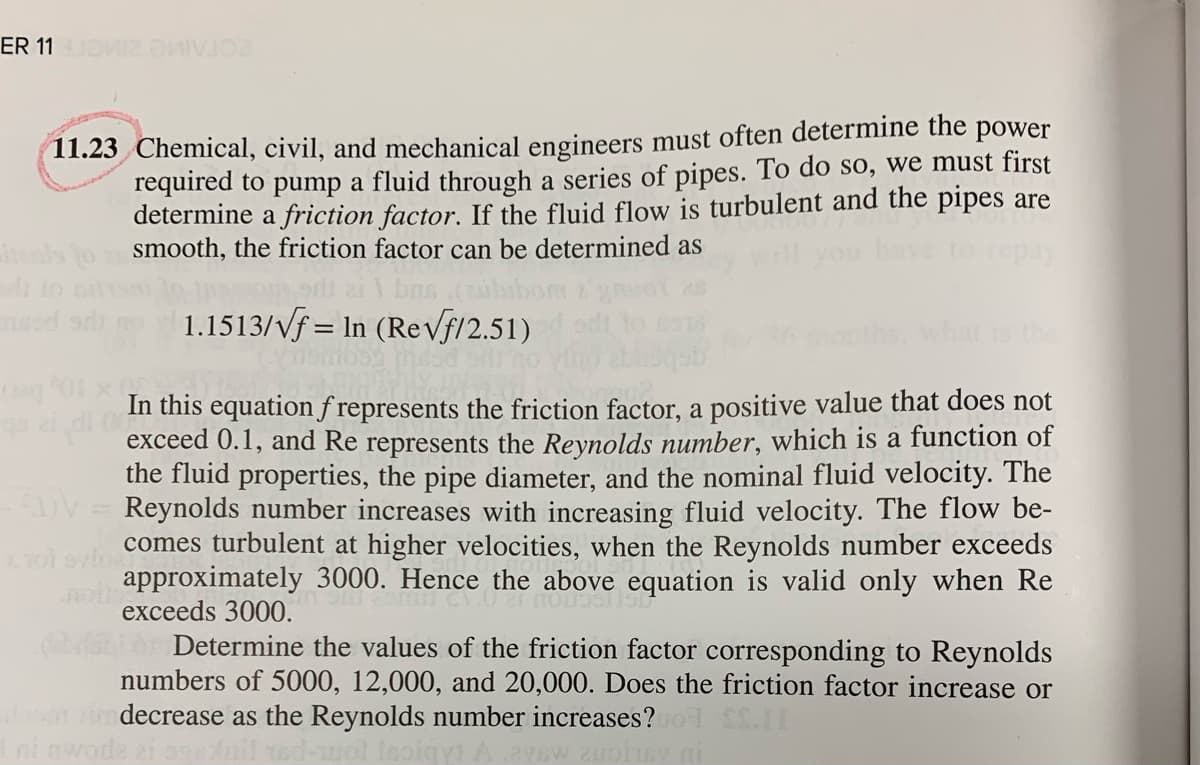11.23 Chemical, civil, and mechanical engineers must often determine the power required to pump a fluid through a series of pipes. To do so, we must first determine a friction factor. If the fluid flow is turbulent and the pipes are smooth, the friction factor can be determined as 1.1513/vf = In (ReVf12.51) In this equation f represents the friction factor, a positive value that does not exceed 0.1, and Re represents the Reynolds number, which is a function of the fluid properties, the pipe diameter, and the nominal fluid velocity. The Reynolds number increases with increasing fluid velocity. The flow be- comes turbulent at higher velocities, when the Reynolds number exceeds approximately 3000. Hence the above equation is valid only when Re exceeds 3000. Determine the values of the friction factor corresponding to Reynolds numbers of 5000, 12,000, and 20,000. Does the friction factor increase or in decrease as the Reynolds number increases?
11.23 Chemical, civil, and mechanical engineers must often determine the power required to pump a fluid through a series of pipes. To do so, we must first determine a friction factor. If the fluid flow is turbulent and the pipes are smooth, the friction factor can be determined as 1.1513/vf = In (ReVf12.51) In this equation f represents the friction factor, a positive value that does not exceed 0.1, and Re represents the Reynolds number, which is a function of the fluid properties, the pipe diameter, and the nominal fluid velocity. The Reynolds number increases with increasing fluid velocity. The flow be- comes turbulent at higher velocities, when the Reynolds number exceeds approximately 3000. Hence the above equation is valid only when Re exceeds 3000. Determine the values of the friction factor corresponding to Reynolds numbers of 5000, 12,000, and 20,000. Does the friction factor increase or in decrease as the Reynolds number increases?
Principles of Heat Transfer (Activate Learning with these NEW titles from Engineering!)
8th Edition
ISBN:9781305387102
Author:Kreith, Frank; Manglik, Raj M.
Publisher:Kreith, Frank; Manglik, Raj M.
Chapter7: Forced Convection Inside Tubes And Ducts
Section: Chapter Questions
Problem 7.33P
Related questions
Question
Solve in MS excel using bisection and Newton-Raphson method! Show all steps in excel

Transcribed Image Text:ER 11O IV
11.23 Chemical, civil, and mechanical engineers must often determine the power
required to pump a fluid through a series of pipes. To do so, we must first
determine a friction factor. If the fluid flow is turbulent and the pipes are
smooth, the friction factor can be determined as
pay
1.1513/vf = In (ReVf/2.51)
is the
In this equationf represents the friction factor, a positive value that does not
exceed 0.1, and Re represents the Reynolds number, which is a function of
the fluid properties, the pipe diameter, and the nominal fluid velocity. The
DV = Reynolds number increases with increasing fluid velocity. The flow be-
comes turbulent at higher velocities, when the Reynolds number exceeds
approximately 3000. Hence the above equation is valid only when Re
exceeds 3000.
Determine the values of the friction factor corresponding to Reynolds
numbers of 5000, 12,000, and 20,000. Does the friction factor increase or
decrease as the Reynolds number increases?
ni nwoda
Expert Solution
This question has been solved!
Explore an expertly crafted, step-by-step solution for a thorough understanding of key concepts.
This is a popular solution!
Trending now
This is a popular solution!
Step by step
Solved in 2 steps

Knowledge Booster
Learn more about
Need a deep-dive on the concept behind this application? Look no further. Learn more about this topic, mechanical-engineering and related others by exploring similar questions and additional content below.Recommended textbooks for you

Principles of Heat Transfer (Activate Learning wi…
Mechanical Engineering
ISBN:
9781305387102
Author:
Kreith, Frank; Manglik, Raj M.
Publisher:
Cengage Learning

Principles of Heat Transfer (Activate Learning wi…
Mechanical Engineering
ISBN:
9781305387102
Author:
Kreith, Frank; Manglik, Raj M.
Publisher:
Cengage Learning